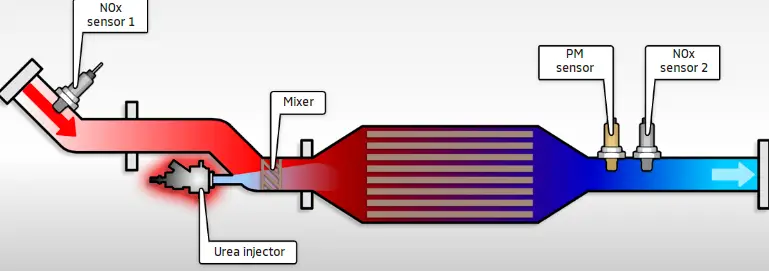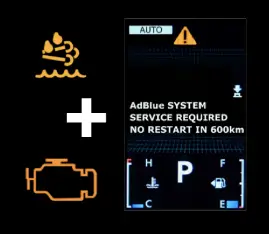The reason is why using.
tle -->Exhaust gases are produced by all combustion engines. While some of them are safe, others, including nitrogen oxides and particulate matter, contain chemicals that are harmful to human health and the environment.
Nitrogen oxide, or NOx, emissions from diesel engines are of particular concern since they can aggravate breathing and respiratory issues in susceptible individuals. It is not surprising that lawmakers from all around the world want to see them eliminated because they also accumulate in the atmosphere to generate smog and acid rain.
Significant reductions in NOX were required with the implementation of the Euro 6 emissions requirements in 2015. In the past, we’ve employed a NOX trap catalyst on some of our vehicles to reduce NOX. This process injects diesel fuel into the exhaust to start a chemical reaction that breaks down NOx into innocuous gases after being absorbed by a specific barite catalyst. However, in 2018, new automobile models will be certified against the Euro 6d emission regulations using even stricter and more accurate tests.

Old vs new catalyst
As a result, we are replacing the NOX Trap catalyst on the L200 Series 6 Diesel with an alternative method called Selective Catalytic Reduction, or SCR. AdBlue, a liquid reduction agent made of urea that is kept in a separate tank and injected into the exhaust, is used by the SCR system to reduce NOx emissions by up to 90%. AdBlue, a liquid reduction agent made of urea that is kept in a separate tank and injected into the exhaust, is used by the SCR system to reduce NOx emissions by up to 90%.
A unique barium catalyst, used in the NOx Trap, absorbs NOx like a sponge. In order to break down the NOx into water, nitrogen, and carbon dioxide, diesel is then intermittently pumped into the exhaust. And this is a linear air/fuel sensor. Even though this system is efficient at eliminating NOx, it cannot be employed in all engine situations. In addition, diesel injection into the exhaust can contaminate the catalyst with sulphur. And this is a linear air/fuel sensor.
Even though this system is efficient at eliminating NOx, it cannot be employed in all engine situations. In addition, diesel injection into the exhaust can contaminate the catalyst with sulphur. The L200 Series 6’s Selective Catalytic Reduction technology is considerably different. The linear air/fuel sensor and temperature sensors have been removed, and the SCR catalyst has been substituted for the NOx Trap catalyst.
A number of new elements have been substituted for them.
Compared to the NOx Trap catalyst, the SCR system is a little more complicated.
After examining the parts, let’s examine the operation of the SCR system.
The first NOx sensor measures the NOx level as the exhaust gas exits the engine.
The first NOx sensor measures the NOx level as the exhaust gas exits the engine.
When NOx is detected, the Dosing Control Unit determines how much AdBlue is needed, and the urea injector subsequently injects that amount of AdBlue into the SCR catalyst.
AdBlue decomposes into ammonia inside the catalyst, where it combines with the NOx to reduce it to harmless nitrogen and water.

The second NOx sensor measures the NOx level when exhaust gases exit the SCR catalyst.
The Dosing Control Unit receives this measurement and, if necessary, can modify the amount of AdBlue administered. This process is repeated over and over.
With the help of the two sensors, the amount of NOx in the exhaust can be reduced by up to 90%.
The SCR catalyst must first warm up to a temperature of about 200 degrees Celsius before it can start working. This temperature is the only one where the chemical reaction can occur.
Through a chemical process called selective catalytic reduction, harmful nitrogen oxides are converted to harmless nitrogen and water.
The first step is to turn the AdBlue into Ammonia.
Urea plus water, H20, make-up AdBlue.
More information about AdBlue here: Adblue is frozen, how to store, and date information?
More information about DPF: Mitsubishi L200 DPF System How Is work?
The water in the combination turns to steam and the urea solidifies when it is introduced into the hot exhaust gas.
The solid urea decomposes into ammonia and carbon dioxide when exposed to hot exhaust gas temperatures and combustion steam.
The solid urea disintegrates into ammonia and carbon dioxide at the high exhaust gas temperatures and steam produced by combustion.
The amount of NOx is then decreased using the ammonia inside the SCR catalyst. A chemical reaction that is sparked by the catalyst turns the ammonia, oxygen, and nitrogen oxides into safe nitrogen and water.
Ammonia can slip past the catalyst if too much is supplied; this is referred to as “ammonia slip.”
Since too much ammonia might be harmful, the NOx reduction rate is capped at 90% to guarantee that as little ammonia slip as possible occurs while yet maximising ammonia consumption. The AdBlue tank has a 21-litre capacity. That ought to cover about 13,000 miles of travel. However, the range may vary based on the driver and the driving environment.
The warning information
There are two different degrees of warning on the L200 Series 6.
If the amount of AdBlue in the tank is about to run out or its quality has considerably declined, the driver will receive a warning.
If nothing is done, “driving enforcement” takes place.
The cautions change with distance.

When there are less than about 1,500 miles of driving range left, the Driver Warning will turn on.
A warning lamp is mounted on the RPM dial’s bottom, and the Multi-Information Display displays a pertinent message.
When the driving range reaches 400 miles, Driver Enforcement kicks in if the AdBlue is not refilled.
The warning light will then start flashing once every second.
The vehicle’s speed will be capped at 40 miles per hour when it approaches zero miles if the driver doesn’t heed this warning. The warning light will flash twice per second when the mileage reaches zero and the engine can no longer be restarted.
If the AdBlue tank does need to be topped out, it is better to do so completely. If that’s not possible, you must add enough AdBlue to provide you with at least a 1,500-mile driving range. That amounts to about 4 litres of AdBlue.

Driver enforcement will also take place if the SCR system isn’t working properly.
The Malfunction Indicator Lamp will light up, the AdBlue warning light will flash, and the Multi-Information Display will show a message.

0 Comments